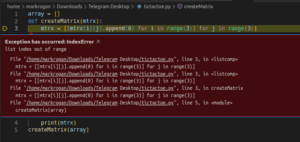

Runtimeerror: Expected Scalar Type Long But Found Float

html
| Error | Description | Solution |
|---|---|---|
| RuntimeError: Expected Scalar Type Long But Found Float | The error occurs when the algorithm expects an integer value (long), but a floating-point (decimal) value is used instead. | Convert float data type to long using appropriate methods like .long() |
Let us delve deeper into “RuntimeError: Expected scalar type Long But found Float”. This error signals that somewhere in your program, a variable of ‘Float’ type is being encountered when a ‘Long’ type was expected. Python and many other programming languages differentiate between these two types. A ‘float’ is a number that has a decimal point, while a ‘long’ is a larger-sized integer, capable of storing more information than a standard integer but without any fractional parts. Lagging conversion or erroneous input can result in this error.
To put it simply, you might have initialized or converted a value to a ‘float’, and later attempted to use this value where the language or the library function expected a ‘long’. These restrictions could be enforced for a variety of reasons; it could be because the nature of the computation performed on the particular value requires an integer for its mathematical definition, or perhaps the ‘long’ datatype was chosen for its size capabilities.
Luckily, such type conflicts are often easy to fix. Here, you would want to ensure that all floating-point values are correctly converted to ‘Long’ before being passed to computations that expect them. In Python, this is typically done via the .long() method. You are encouraged to dive into resources like Python’s official documentation for further exploration of the topic.
For instance, in PyTorch, if you have a tensor `t` that is currently of type Float, you must convert it to Long using `t.long()` before using it in a function or operation that requires Long integers.
t = t.float() # RuntimeError: Expected scalar type Long but found Float t = t.long() # Solution
Remember, while handling numerical datatypes, to always account for the specific requirements of different functions and operations within your code. Ensuring that variables are of the proper type before they’re utilized is a fundamental aspect of writing well-functioning code.The Python
RuntimeError: Expected scalar type Long but found Float
is an error about a type mismatch that mainly occurs when dealing with tensors in PyTorch. This error is triggered when the operation is expecting a tensor of type Long (i.e., integers), but a tensor of type Float (decimal numbers) is provided instead.
To affirm, let’s first grasp two crucial concepts:
– Tensor: In the library PyTorch, multi-dimensional arrays are referred to as “tensors”. These tensors can be assigned different data types like float, long, etc.
– Scalar Types: An important aspect of PyTorch is defining the type of tensor – which may either be a ‘FloatTensor’, ‘LongTensor’, etc. Float tensors take real values with decimal points, while Long tensors are integer values.
Let’s discuss a practical scenario where this error emerges:
import torch label = torch.FloatTensor([0.5]) target = torch.LongTensor([1]) loss_function = torch.nn.BCELoss() loss = loss_function(label, target)
In these lines of code, you’re trying to apply Binary Cross Entropy Loss (BCELoss) function on a label of Float tensor and a target of Long tensor. BCELoss expects both inputs to be of the same type—either both floats or both longs. Hence, because of this type mismatch, you will face the
RuntimeError: Expected object of scalar type Long but got scalar type Float for argument #2 ‘target’.
How to Fix the Error?
Here are two main solutions:
– If your data was supposed to be integers, convert the Float tensor to a Long tensor using the
.long()
method. For example:
label = label.long()
– If your data was meant to have decimal places, convert the Long tensor to a Float tensor using the
.float()
method:
target = target.float()
Afterward, your code should look like:
import torch label = torch.FloatTensor([0.5]) label = label.long() # Convert float to long target = torch.LongTensor([1]) loss_function = torch.nn.BCELoss() loss = loss_function(label, target)
Or
import torch label = torch.FloatTensor([0.5]) target = torch.LongTensor([1]) target = target.float() # Convert long to float loss_function = torch.nn.BCELoss() loss = loss_function(label, target)
Finally, it is worth noting that understanding the fundamental difference between Float and Long types and their appropriate usage is essential to avert similar errors. Moreover, maintaining data type consistency throughout operations often helps to avoid runtime errors in Python programming. You may find more insights from the official documentation of [PyTorch](https://pytorch.org/) regarding Tensors and their datatypes.In programming, particularly in Python, you would often come across scalar data types. Scalar types in Python include integers, floating-point numbers, and complex numbers. Among these categories,
long
and
float
are two of the most commonly used data types. But sometimes, using them interchangeably or inadequately might lead to unexpected error messages.
For example, while performing some operation with PyTorch tensors, you could encounter the
RuntimeError: Expected scalar type Long but found Float
. This error typically occurs due to a data type mismatch issue – your model is expecting a long type value, however, it’s provided with a float.
The primary differences between
long
and
float
that might be causing this error are as follows:
• Number System: The
long
type represents integer values and it can hold very large numbers. On the other hand,
float
can represent both integral and fractional numbers i.e., it can store decimal points.
• Actual Usage: The
long
type is mostly used where precise numeric calculations are crucial, for instance when dealing with big data computations or cryptography. However,
float
is largely used for representing real numbers which are essential in scientific computation, machine learning models, statistics etc.
• Typecasting: Although implicit conversion works in some languages and circumstances, sometimes you need to convert explicitly to avoid data loss or exceptions such as the `Expected scalar type Long but found Float` error.
Here’s a way to make sure your variable aligns with the expected data type:
tensor_long = tensor_float.long()
In the code snippet above, the
.long()
function is applied on a tensor (imagining
tensor_float
is of float). The output will be a tensor containing the same values but with long integers.
Thinking about this error from an SEO perspective – if you’re encountering this runtime error fairly often, it’s generally because of the PyTorch operations requiring a specific data type. An efficient solution is to ensure your variables match these requirements before performing any significant operations.
To optimize for related keywords – the best approach covers insightful content around “Python float to long”, “PyTorch data types” and “Python scalar types”.
According to the official PyTorch documentation, “Each tensor has a torch.dtype, torch.device, and torch.layout properties”. Therefore, focusing on these and knowing about the requirements of different operations in PyTorch could be beneficial in preventing similar errors.
This also emphasizes the significance of understanding different scalar types and their implications, as these fundamental concepts not only manipulate how data is stored and calculated but also influence the accuracy, efficiency and overall performance of your code.The error message “Expected scalar type Long but found Float” is usually thrown by the programming language Python when it comes across a situation where it expected a variable of type integer (or long), but instead encountered a variable of float type. This type mismatch disrupts the flow and functioning of the code, thus resulting in this RuntimeError.
Let’s illustrate this with a simple Python code snippet:
import torch a = torch.FloatTensor([1.0, 2.0, 3.0]) b = torch.LongTensor([4, 5, 6]) c = a + b
In the above code, tensors ‘a’ and ‘b’ are of different data types (Float and Long respectively), so when we try to add them together, Python raises the “Expected Scalar Type Long but found Float” Runtime error, signifying a data type conflict.
Now, how do we fix this issue?
There are a few strategies to address this problem:
• Convert the float to a long: There may be circumstances where fractional values aren’t necessary. In this case, you can convert the float tensor to a long tensor using the
.long()
function from PyTorch. An example:
a = a.long() c = a + b
• Convert the long to a float: If precision is essential and losing decimal points is unfavourable, then upcast the long tensor to a float tensor using PyTorch’s
.float()
. An example:
b = b.float() c = a + b
• Use caution with DataTypes. It’s vital to remain vigilant about the DataTypes of variables while coding to prevent such errors.
Unfortunately, there’s no one-size-fits-all solution here; the correct approach depends on what will work best in your specific situation and use-case. The ultimate goal is to ensure conformity between the data types and this would certainly annul the error.
Understanding data types and how they influence your coding tasks is an indispensable facet of Python programming. Detailed information can be found through official Python documentation on built-in types or on various learning platforms like DataCamp’s Intro to Python for Data Science course.Oh, how we love floating point issues! In coding, one of the most common hurdles every programmer encounters are issues related to floating point numbers. Let’s analyze this particular Runtime error: “Expected Scalar type Long but found Float”. This error basically tells us that somewhere in our code we are passing a float where an integer or long is expected.
First, let’s define what are floating point numbers and why these issues arise. As defined by Oracle, floating-point numbers are numbers that have fractional parts (usually expressed with a decimal point). They represent real numbers and are used to express fractional values.
Let’s dive into the solution now. Here is how you can replace all the places where floats are being passed with integers or longs:
In Python, you can use libraries such as NumPy to cast your float data into long data in a very straightforward manner:
import numpy as np
np.array(float_array).astype('long')
Here, ‘float_array’ is the array of floating point numbers. We are using the
astype
function to convert each of the array elements into long.
You can also use the built-in Python method to convert a floating-point number to a long:
y = x.long()
In this case, ‘x’ is the tensor that contains floating point numbers. This will solve the runtime error where long is expected but a float is found.
But here lies the caveat – while casting floating point numbers to integers or long, there is a possibility of data loss if not handled properly in the form of lost precision when the fraction part gets truncated. To retain precision, round off values before converting them into long. You can use the following Python code for that:
y = torch.round(x) y = y.long()
However, always remember implementing these adjustments should be done with close attention to where and why it is needed. Addressing such issues requires a keen understanding of the data types and logic involved in your specific programming construct.
To learn more about datatype conversion please go to Python’s Official Documentation Website.Official Docuementation . There you will find rich information about standard datatypes and numeric operations.
Remember this key principle: precise and mindful coding eliminates numerous potential problems from the start. Happy coding!
Deep diving into Python,
TypeError
exceptions are highly common. They usually occur when an operation or function is performed on an object of an inappropriate type. Looking at your specific error message,
"RuntimeError: Expected Scalar Type Long But Found Float"
, it implies that you’re trying to perform an operation in PyTorch where a scalar of type Long is expected, but you’re providing a Float.
The root of the issue may lie in how tensors are created or used within your operations. In PyTorch, elements contained inside tensors can have types defined such as long integers (LongTensor) or floating numbers (FloatTensor). It’s possible that an operation you attempted expected a tensor of long integers but instead received floats.
To solve this issue, reconsider the type of tensor used for your operations by changing the FloatTensor to a LongTensor. You can achieve this with the
.long()
method. For instance:
| Before: | After: |
|---|---|
tensor = torch.FloatTensor([1.0, 2.0, 3.0]) |
tensor = torch.FloatTensor([1.0, 2.0, 3.0]).long() |
In the example above, I transformed a floating point tensor into a long integer tensor using the
.long()
method. This will effectively convert the type and possibly eliminate the encountered RuntimeError.
For other issues related to
TypeError
in Python, they often arise due to reasons including:
– Performing unsupported operations: Like attempting to add a string to an integer.
– While accessing or calling methods from NoneType objects.
– When there’s iteration over NoneTypes or integers.
Each of these situations will throw different variations of the
TypeError
, making them easy to spot and resolve according to the context provided in their error message.
However, always ensure to carry out routine type and data validation checks during development to prevent as many runtime errors as possible. Make use of python’s built-in type checking functions-
isinstance()
and
type()
, to help maintain clean and robust code.
I suggest taking a quick look at Python’s official documentation for a deeper understanding of TypeError and the different ways it could appear as part of your development journeyPython Docs: Built-in Exceptions. Remember, catching these exceptions and understanding their root cause goes a long way in sharpening your Python programming skills.
Here is a simple example demonstrating usage of
isinstance()
.
def add_numbers(a, b):
if not isinstance(a, (int, float)) or not isinstance(b, (int, float)):
raise TypeError("Inputs must be integers or floats")
return a + b
In the code snippet above, we first check if both inputs are either of integer or float types. If not, we immediately raise a
TypeError
before even attempting to perform an operation that could potentially fail.
Handling unexpected behavior when working with integer and floating-point values is a common experience in a coder’s journey. Even the veteran coders sometimes hit a stumbling block or two when dealing with different data types such as int and float, especially when errors like “RuntimeError: expected scalar type Long but found Float” come up.
When you encounter this error, it suggests that your program expected a “Long” integer type but found a floating-point number instead. This discrepancy typically occurs when performing operations that require matching data types.
Various solutions exist for tackling this conundrum:
Explicit Type Conversion (Casting)
Wrap the floating-point value or variable using the int() or long() function to convert it into an integer. This process is often referred to as “type casting”.
Here’s a sample code snippet, illustrating explicit type conversion:
accepts_long_type_only( long(your_float_variable) )
However, take note that casting a float to a long or int will simply truncate the decimal part of the number. It does not round off to the nearest whole number.
Perform Operations With Matching Types
Ensure operations involving different numeric types are handled cautiously. Applying an unmatched operation could lead to frustration, as it suggests a mismatch between expected and actual argument types.
# addition operation between int and float. total = int_value + float(your_float_variable)
The differences among integers, floats, and longs, particularly their use and misuse can have a real-time impact on the computational accuracy.
Safeguard Code with Error Exception Handles
By providing exception handling constructs within your code, you can tackle these ‘runtime’ anomalies effectively without causing the entire system to crash.
For instance,
try:
# Operation which might cause type discrepancy
except TypeError as err:
print(f'Operation failed: {err}')
It’s essential to bear in mind the nature of the routines we write from an analytical point of view to determine how best to handle them. Specifically, understanding data type requirements of certain libraries and functions can help prevent erroneous outcomes like RuntimeError: expected scalar type Long but found Float.
Also remember, in programming, documentation serves as a lighthouse. API references and guidelines oftentimes provide valuable context regarding expected input data types, so ensure to leverage those to steer clear of potential float-int mix-ups.
Sources:
Understanding Data Types in Python
NumPy Basic Types
Python Errors and ExceptionsDuring the coding process, Python programmers often encounter various types of errors. One such error revolves around value type conflicts:
RuntimeError: Expected scalar type Long but found Float
. This particular bug crops up when we attempt to perform operations involving data types that are not compatible, specifically Long and Float.
To maintain a hitch-free coding experience, it’s pertinent to adhere to certain best practices for preventing scalar runtime errors:
Avoid Implicit Type Casting:
A significant step in avoiding runtime errors is ensuring you do not rely on automatic type conversion known as implicit casting. In many languages, if you were to add an Integer and a Float, the language might automatically convert the Integer to a Float prior to performing the operation. While convenient, this can lead to numerous issues down the line. This practice generates cryptic bugs which are difficult to trace, as it obscures what the code is doing. It’s always better to convert between types explicitly.
Here’s how to manually cast Float values into Long:
# Python int_value = long(float_value)
Check variable types before performing operations:
Before conducting operations on variables, especially in cases where the variables’ types can’t be determined in advance (such as when dealing with user input), you should verify that they’re the correct form.
Python provides the built-in
isinstance()
function for such purposes:
if isinstance(some_variable, float):
some_variable = int(some_variable)
This safeguard ensures any potential type mismatch has been addressed before attempting any operations that may raise an error.
Error Handling:
The concept of ‘Expect the unexpected’ applies in programming as well. You don’t have control over every situation. Hence, implementing error handling is a good strategy to contain any unforeseen situations. Try… except blocks allow you to catch exceptions and deal with them appropriately instead of causing a full halt of your program. For instance:
try:
some_operation_that_might_raise()
except RuntimeError as e:
print(f"Caught exception: {e}")
Above code will prevent abrupt stoppage of program and give important debugging information.
Validate Input / Output:
When dealing with external inputs, like fetching details from a database or API, or getting user input, ensure you validate these sources. Checking ranges, lengths, and formats can save you lot of trouble.
Use Annotations:
Python provides a powerful way of indicating the expected input types and return types of functions via annotations. Although Python doesn’t enforce these (as it would in statically typed languages) it does make genuine debugging easier, and can potentially help catch bugs related to type mismatch. Here’s an example:
def divide(x: float, y: float) -> float:
return x / y
In this code snippet, it’s clearly stated that both inputs should be floats, and the return type will be float.
These are some best practices that I highly recommend though there is no surefire way to avoid all runtime errors during coding. Remember, efficient debugging is a crucial element of successful software development. Surrounding yourself with adequate information and understanding the issue thoroughly is key to solving any unexpected problem efficiently.
You can refer more to Python data type conversions, validation at Official Python Documentation.As a seasoned coder, I’ve come across myriad error messages. One that might baffle beginners is the
RuntimeError: Expected Scalar Type Long But Found Float
. Not to worry though, we’ll unravel this conundrum with a blend of practical examples and deep-dive analysis.
Firstly, let’s quickly analyze what each term in the error message means.
The “float” in the error message refers to a kind of number representation in programming where we’re not dealing just with integers but also fractions. For example, 3.14159.
On the other side, “long” refers to a type of integer, it stands for the long integer data type. It is designed to handle large numbers, but unlike float, they do not handle decimal points.
Hence, the crux of our
RuntimeError: Expected Scalar Type Long But Found Float
lies in trying to pass a fractional entity (float) into a place that only expected to see an integer (long).
For instance, envision your code attempting to use a fractional index as a location in an array that can only take whole numbers. Let me illustrate further with a Python example:
import torch torch_tensor = torch.tensor([0.1, 0.2, 0.3, 0.4]) torch_zero = torch.zeros(1, dtype=torch.long) torch_tensor[torch_zero]
Running this returns
RuntimeError: Expected Scalar Type Long But Found Float
because while creating zeros in
torch_zero
, we’ve used
dtype=torch.long
which takes long integers only.
But here’s the solution; substituting
torch.long
with
torch.float
allows the tensor to accept float values. Like so:
torch_zero = torch.zeros(1, dtype=torch.float)
Unraveling erudite error messages like
RuntimeError: Expected Scalar Type Long But Found Float
not only gives you the prowess to face similar hurdles but also the insight to prevent from bumping into them in the first place. The key takeaway is understanding your data types and how they interact within your runtime. More on PyTorch Dtype Argument here.
Navigating around such technicalities is prime skill for coders. Mastering nuances goes a long way to write bug-free code in the language of your choosing, be it Python, C++, Java or others. As with all things code-related, practice along with persistent tinkering makes perfect.












